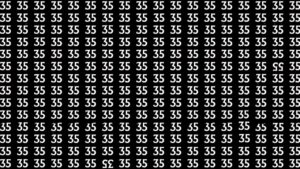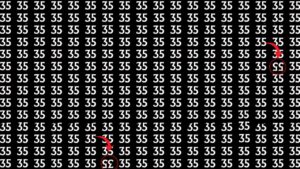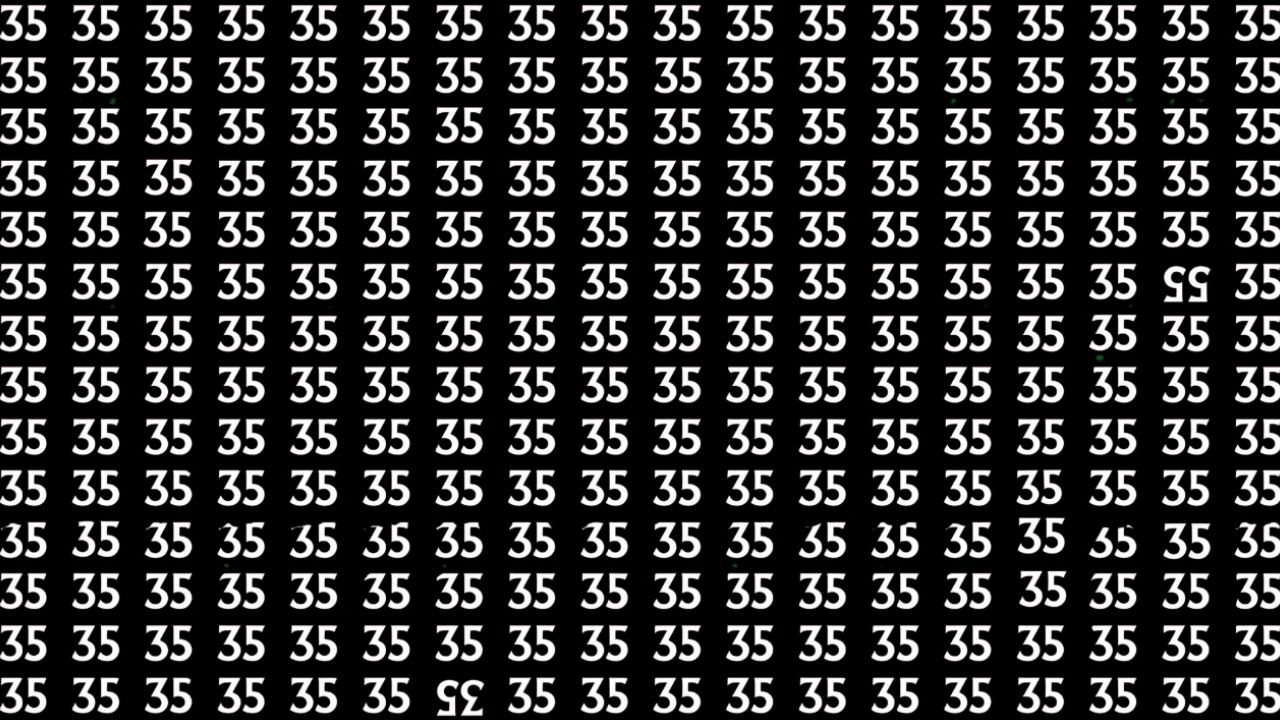The internet has witnessed countless viral challenges, but few have captured global attention quite like the latest optical illusion phenomenon sweeping social media platforms. This deceptively simple puzzle challenges viewers to locate a hidden number “55” concealed within an extensive grid of identical “35s” – all within a mere 8-second timeframe. What appears straightforward at first glance quickly reveals itself as a masterclass in visual deception that has left millions scratching their heads in bewilderment.
The Viral Sensation Taking Over Social Media
This particular optical illusion represents more than just entertainment; it serves as a fascinating window into the complex mechanisms of human visual perception. The challenge has generated millions of attempts worldwide, yet success rates remain remarkably low despite its seemingly straightforward premise. Social media platforms have become battlegrounds where users compete to demonstrate their visual acuity, sharing screenshots of their attempts and challenging friends to beat their times.

The puzzle’s viral nature stems from its perfect balance of accessibility and difficulty. Anyone can attempt the challenge regardless of age, education, or background, yet the solution proves elusive enough to maintain engagement across diverse demographics. This universal appeal has transformed a simple visual exercise into a global phenomenon that continues to generate discussions about human perception and cognitive processing.
Understanding the Science Behind Visual Deception
How Pattern Recognition Shapes Our Perception
The brilliance of this optical illusion lies in its sophisticated exploitation of our brain’s natural pattern recognition system. When confronted with repetitive visual information, our minds automatically create mental shortcuts to process data more efficiently. This evolutionary adaptation, while beneficial for navigating daily life, becomes a significant hindrance when attempting to identify subtle variations hidden within uniform patterns.
The numbers 35 and 55 share remarkably similar visual characteristics, both containing curved and straight lines that can appear nearly identical during rapid or peripheral viewing. This similarity forms the foundation of the illusion’s effectiveness, as our visual system tends to focus on overall patterns rather than meticulously examining each individual element.
The Role of Cognitive Shortcuts in Visual Processing
Our brains operate on principles of efficiency, constantly seeking ways to reduce processing demands while maintaining functional accuracy. When presented with repetitive patterns, neural pathways become primed to expect consistency, making unexpected variations significantly harder to detect. This phenomenon explains why locating the hidden 55 among numerous 35s proves so challenging, even when we consciously know what we’re searching for.
Research in cognitive psychology demonstrates that our visual processing system relies heavily on predictive mechanisms. These systems excel at identifying familiar patterns but struggle when confronted with subtle anomalies embedded within expected sequences. The time constraint adds another layer of complexity, as pressure can narrow our attention span and reduce systematic scanning abilities.
Mastering the Art of Visual Detection
Strategic Approaches to Solving Visual Puzzles
Successfully completing these challenges requires abandoning random visual searching in favor of systematic scanning methodologies. The most effective strategy involves dividing the image into distinct quadrants and methodically examining each section rather than attempting to process the entire grid simultaneously. This approach reduces cognitive load while ensuring comprehensive coverage of the visual field.
Professional observers, including medical diagnosticians and quality control specialists, employ similar techniques in their daily work. They understand that rushed or unfocused observation often leads to missed details, regardless of the observer’s experience level. By implementing structured scanning patterns, success rates increase dramatically across various visual detection tasks.
Training Your Brain for Enhanced Perception
Regular engagement with optical illusion puzzles can significantly improve visual processing speed and accuracy over time. These exercises strengthen neural pathways responsible for detail detection while training the brain to resist pattern-based assumptions. The benefits extend far beyond entertainment value, contributing to enhanced observational skills applicable in numerous professional and personal contexts.
The development of superior visual perception abilities requires consistent practice and patience. Like physical exercise, cognitive training produces gradual but meaningful improvements in performance. Individuals who regularly challenge themselves with visual puzzles often report enhanced attention to detail in other areas of their lives, from reading comprehension to workplace productivity.
The Psychology Behind Viral Visual Challenges
Why We’re Drawn to Testing Our Limits
The explosive popularity of this optical illusion reflects our collective fascination with testing cognitive abilities in easily shareable formats. These challenges tap into fundamental human desires for self-assessment and social comparison, providing immediate feedback about our perceptual capabilities relative to others. The competitive element transforms solitary puzzle-solving into a social activity that encourages participation and engagement.
Social media platforms have revolutionized how we consume and share educational content, transforming scientific curiosities into competitive entertainment. Users eagerly post their success rates, challenge friends to beat their times, and discuss strategies for improvement. This phenomenon demonstrates how educational material can achieve viral status when presented in engaging, accessible formats.
The Educational Value Beyond Entertainment
While these puzzles provide immediate entertainment, they also serve as valuable tools for understanding human perception limitations. Educators and cognitive researchers increasingly utilize similar visual challenges to demonstrate concepts related to attention, pattern recognition, and the reliability of human observation in various contexts.
The implications extend beyond academic interest, offering practical insights into fields ranging from user interface design to safety protocol development. Understanding how visual perception can be compromised helps professionals create more effective systems that account for human cognitive limitations.
Tips for Improving Your Visual Perception Skills
Developing Systematic Scanning Techniques
Success in visual detection tasks depends largely on developing consistent, systematic approaches to scanning. Rather than relying on luck or quick glances, effective observers employ structured methods that ensure complete coverage of the visual field. This might involve scanning from left to right, top to bottom, or using other organized patterns that prevent overlooking critical areas.
The key lies in maintaining focus and resisting the urge to rush through the process. Even under time pressure, a systematic approach typically yields better results than frantic, random searching. Professional applications of these skills, from airport security screening to medical imaging interpretation, rely on similar methodical approaches to maximize accuracy.
Building Attention and Concentration
Enhanced visual perception requires sustained attention and concentration abilities that can be developed through practice. Regular meditation, mindfulness exercises, and focused attention training can significantly improve performance on visual detection tasks. These activities strengthen the cognitive resources necessary for maintaining concentrated focus over extended periods.
The modern world presents numerous distractions that can undermine our natural attention capabilities. By consciously practicing focused attention skills, we can counteract these effects and maintain sharp observational abilities essential for both professional success and personal safety.
The Solution and What It Teaches Us
The hidden number 55 in this particular optical illusion demonstrates the remarkable ways our brains can overlook obvious details when confronted with overwhelming pattern repetition. Once the solution is revealed, many viewers express amazement at how they could have missed something that now appears clearly visible. This reaction illustrates the powerful influence of expectation and pattern recognition on visual perception.
The lesson extends beyond simple entertainment, offering valuable insights into the reliability of human observation in critical situations. Understanding these limitations helps us develop better systems, protocols, and verification methods that account for natural human cognitive biases and perceptual blind spots.

Frequently Asked Questions
Q: Why do some people find the hidden number immediately while others struggle? A: Individual differences in visual processing speed, attention control, systematic scanning habits, and prior experience with similar puzzles significantly impact performance. Some people naturally employ more effective scanning strategies, while others rely on less systematic approaches.
Q: Can practicing these optical illusion puzzles improve my overall observation skills? A: Absolutely. Regular engagement with visual puzzles strengthens neural pathways responsible for detail detection and pattern recognition. These improvements often transfer to other areas requiring careful observation, from reading to workplace tasks.
Q: Are there specific techniques to solve these puzzles more quickly? A: Yes. Systematic quadrant-by-quadrant scanning proves more effective than random searching. Additionally, taking a moment to relax and focus before beginning can improve performance compared to immediately jumping into frantic searching.
Q: What makes this optical illusion particularly challenging? A: The combination of similar-looking numbers (35 and 55), repetitive patterns that trigger predictive processing, and time pressure creates multiple layers of difficulty that challenge our natural visual processing systems.
Q: How long should I practice to see improvement in these types of challenges? A: Most people notice improvements within 1-2 weeks of regular practice, with significant gains typically occurring after a month of consistent engagement with various visual puzzles and attention exercises.
